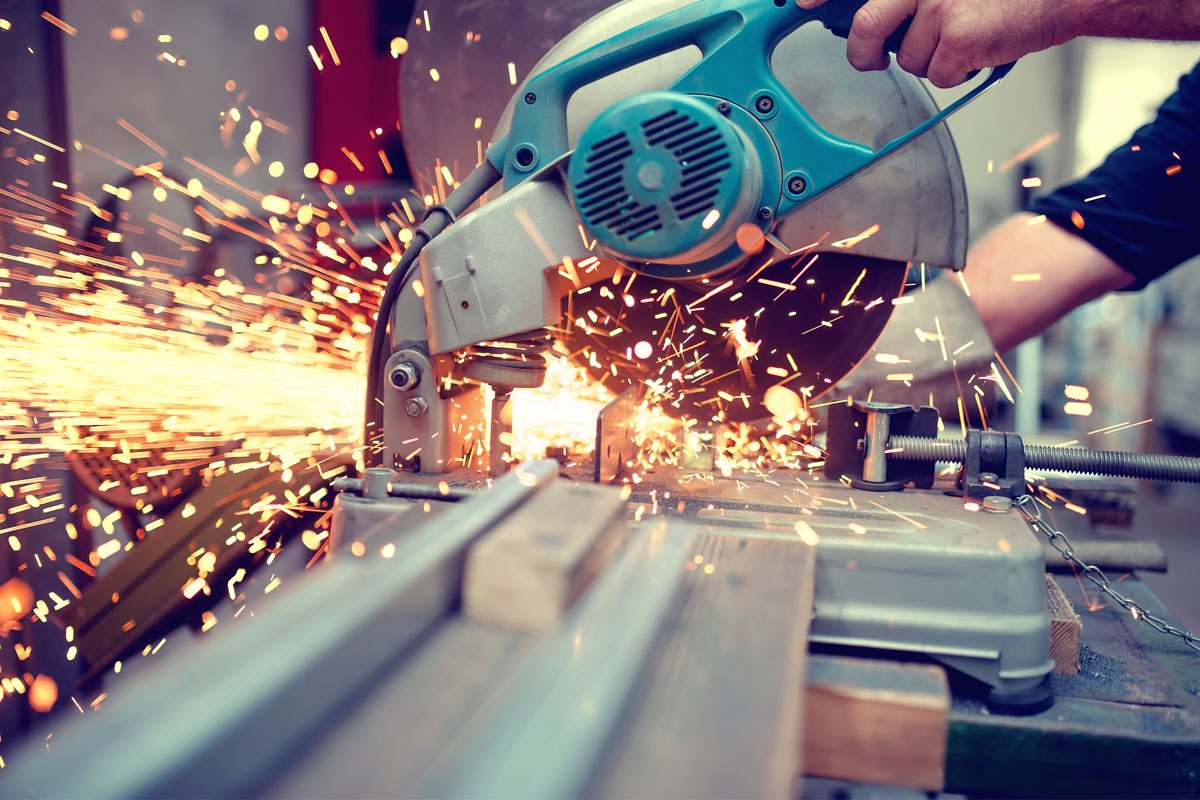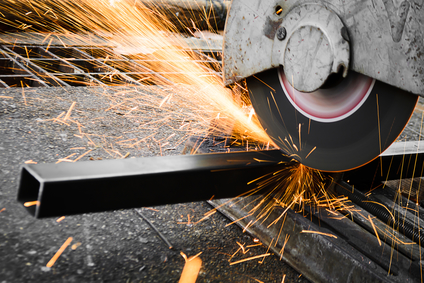Struggling to cut through metal with a jigsaw? You’re not alone. This complete guide will provide you the step-by-step instructions and best blades to help you accurately make cuts in metal.
Whether you need to make precise curves or straight cuts, this guide has got you covered.
Doing creative work with a jigsaw can be a lot of fun and it is an extremely versatile tool when it comes to cutting metal. It can provide you with relatively precise cuts, and there are many different blades available for various types of cutting material. With some practice and knowledge about the best blades for the type of metal you’re working with, you’ll be able to achieve great success in your projects.
This comprehensive guide will equip you with the knowledge to help you understand how to cut metal with your jigsaw safely and accurately. We will look at the techniques required, providing tips and tricks along the way. We will also explore the best blades for different types of metal, so that you can get through any job quickly, easily, and without fear of damaging or ruining your work material.
Explanation of the topic
Cutting metal with a jigsaw can be challenging but is achievable with the correct technique and the right blades used. It requires precautions, more patience, and preparation than most materials such as wood or plastic. However, if done correctly, it can make precision cuts into metal more reasonably than other saws or tools. First, you must ensure you have the appropriate jigsaw suitable for cutting metal and that you have the right blades to get optimal results. Additionally, it’s essential to familiarize yourself with your tools and practice the techniques before cutting the actual project.
When cutting metal with a jigsaw correctly, it is similar to that of wood or plastic but involves slower speeds and movement allowing for cleaner lines on your projects:
- Choose an appropriate blade for cutting into metal. The type of blade being used will depend mostly on what type of project you are creating; there are both wood and metal blades available that range from thin scroll blades to thicker ones meant for creating straight lines in thin metals such as aluminum or stainless steel. Be sure to select one compatible with your saw’s capabilities.
- Mark out sections using an oil-based pen or scribe—this makes spotting where cuts need to be made easier while providing a line which will enable a cleaner cut without having any marking present on the final product when complete
- Ensure there is adequate clamping security in place—a handheld guide like clamps ensure a stable object provides proper support while also concentrating power evenly so that jagged edges aren’t created during tracing
- Maintain pressure when steady continual pressure helps avoid wobbling resulting in smoother results along edges
- Finally slow down speed when decreased speed helps create clear lines while reducing risk of over-cutting edges

Importance of using proper techniques and blades when cutting metal with a jigsaw
Using proper techniques and blades when cutting metal with a jigsaw is essential. Learning the appropriate techniques and best blades can make the process of cutting metal simpler and easier, while also increasing your precision and quality of work.
To begin with, it is important to remember that a jigsaw is primarily designed to cut wood. It can be used to cut other materials such as plastic, non-ferrous metals, and even thin sheet metal, but this should only be done if the saw has been designed for such use or has an appropriate blade installed. Otherwise you risk damaging both the saw and your material.
When you do choose to take on the task of cutting metal with a jigsaw, it is important to select the right blade for the job. The right blade can drastically change how well your cuts are made: too thick a blade may be unable to make all turns required for your cut pattern; too thin may break in trying. Generally speaking, “cold-edged” blades offer more resistance when it comes to curves, allowing for cleaner lines; “multitooth” blades typically include both up-and down-cutting teeth that allow for easier turns in any direction; and “tungsten-carbide” blades offer extra strength for harder materials like stainless steel piping or rods.
To make sure that your efforts are successful, it helps to follow some basic cutting techniques. Make sure that you align the saw along your line before making a cut — this will help ensure precision in results — and always hold onto both handle grips firmly as you start cutting into material. Cut slightly slower than normal on curves or tight angles (with smaller saws) while still keeping a steady line so as not to become off balance or lose control of the saw during these maneuvers — this will provide crisp ends without any debris left behind on curves or nooks in your design shape.
Furthermore, remember that when using an electric jigsaw always keep an eye on cord lengths: keep them clear from workpieces as well provide additional slack so they don’t get snagged by either workpieces or yourself during operation! Finally – safety eyewear should always be worn before beginning any operation!

Techniques for Cutting Metal with a Jigsaw
Circles, curves, and intricate details can be difficult to cut into metal with other tools. Cutting with a jigsaw allows you to make precise cuts with ease. Here are some tips and techniques for getting the most out of your jigsaw when cutting metal.
Before getting started it’s important to remember that not all jigsaws are designed for use on metal; taking care of your jigsaw will also ensure it’s longevity when cutting metal. Making sure your blades are in good condition will help ensure a clean and accurate cut. There are many blades specifically made for cutting various types of metals, so be sure to use the correct blade for the job you’re working on. Using the wrong blade can cause problems such as teeth breaking or chips being left behind that could ruin the material you’re cutting. It’s best to adjust the speed slider depending on how thick or hard the material is that you need to cut through; metals often require slower speeds than wood would for example.
Using a lubricant can also prevent blade gumming (dinging after lengthy periods of time) by reducing frictional heat building up around the blade – Some good options include waxes like carnauba or white petroleum greasewhich act as a coolant which should be applied each time before beginning a new cut. Applying too quickly can cause smoke and burning odors, so always have ventilation when dealing with these materials – this will also help keep temperatures lower so your equipment runs more smoothly overall! Additionally, when dealing with softer metals like aluminum foil it may be necessary to pin down specks of debris onto surfaces before starting, this way pieces don’t get thrown around which could ruin accuracy and safety levels in most cases depending on what type of material you’re using (Ie sheet steel).
After completing your cuts make sure angular edges or bent pieces aren’t sharp; if necessary, straighten edges out using grinding wheels or files instead of exposing yourself or someone else to dangerous projectiles coming from poor planning beforehand!
Safety precautions and equipment
Before beginning to cut metal with a jigsaw, it is essential to take the time to select the right equipment and ensure that any safety measures are in place. In this complete guide, you will find helpful information and recommendations for safety precautions, equipment selection, and optimal cutting strategies when using a jigsaw.
Safety Precautions When cutting metal with a jigsaw, it is important to follow proper safety precautions. Wear protective gear such as goggles or a face shield to protect your eyes from flying particulate. Gloves may also be beneficial due to the possibility of splinters or sharp edges. Also be sure to avoid wearing loose clothing that could get caught in the saw blade or become a distraction while working with power tools. Before beginning your cut, make sure your work environment is free of debris and that there are no trip hazards that could cause injury while working on your project.
Equipment Selection When choosing the right jigsaw for your project consider which features are most important such as power output and type of blade used. Selecting an appropriate blade is necessary for completing successful cuts; backward-leaning teeth blades create rough cuts while “skip-tooth” blades allow for smoother finishes. For specific applications, check out our guide on best blades for cutting metal with a jigsaw (link) for more information about which type of blade works best for each type of material you’ll be working with!
Preparing the metal for cutting
To ensure smooth, clean cutting, begin by carefully preparing the metal. No matter what type of metal you are cutting, take the following steps to prepare it:
- Measure and mark your cut line with a permanent marker or marking tool. If possible make sure one end is on a solid surface to steady it.
- Put on protective eye-wear and gloves when cutting metal as small shavings or sparks may fly during operation.
- Securely fasten the metal using a clamps so that it remains still during the cutting process. Make sure that there are no people or animals in the work area who could be injured if things slip out of position.
- Sand off any rust or paint from where you’ll be making your cut as this can interfere with your saw blade’s ability to make an accurate cut in the metal. Use coarse sandpaper and then finish off with a finer grade of sandpaper to create a smooth surface before beginning the cut. Be careful not to strip away too much material as this could affect accuracy when you make your final cut with the blade itself – only sand down enough so that the blade can get through the material easily and safely without jerking or force being applied by you while trying to push it through too closely to rust, paint, etc…
Cutting techniques for different types of metal
The type of metal you are cutting with a jigsaw will determine which blade, technique, and speed to use. Generally, the thicker and harder the metal, the slower the cutting speed should be. Here is an overview of the best techniques and blades for different types of metals.
Soft Metals
Soft metals such as aluminum and copper are relatively easy to cut with a jigsaw because they possess a low degree of hardness. The best blade to use is bi-metallic blades with variable teeth configurations since this will help reduce heat buildup while cutting. It is important to use a slow setting when cutting these metals since they are easily overheated by faster speeds.
Mild Steel
Mild steel is easy to cut with a jigsaw due its softness, but it tends to be more difficult than other metals as it has a higher degree of hardness that emits more heat during the process. To avoid melting or burning away parts of your material, it’s important to keep your speed limit slow at medium-high settings. For cutting mild steel choose bi-metal blades with variable teeth for the tightest possible curve radius during cuts.
Stainless Steel
Stainless steel is one of the trickiest materials for beginners when working with sheet metal as it tends to overheat very quickly and lose its edge if not managed properly . There are two types of blade suitable for this material: tungsten carbide-tipped (TCT) blades or high speed steel (HSS) blades both suitable for straight/curve cuts on stainless steel. Before commencing your work make sure your saw has enough power and set your speed at low–low-medium range settings so that no serious heating occurs while you’re working on stainless steel sheets.

Choosing the Best Blades for Cutting Metal with a Jigsaw
Choosing the blades for jigsawing metal can make all the difference in the quality of your finished product. There are several factors to consider when selecting blades and it is important to understand how they work.
Blade Types: The type of blade you choose will depend on what materials you are cutting and the complexity of your cut. Generally, blades that have a higher concentration of carbide tipped teeth are best for metal cutting. Reverse Tooth blades are a popular choice as they start by cutting on the down stroke when cutting metal which gives more control and less chipping or dislodging of metal chips in intricate cuts. U-shank (U type) blades may be more robust and handle thick metals better than standard T-shank (T type) blades, however, U-shank does not fit all jigsaws so check compatibility before purchasing them.
Length: When cutting metal, it is recommended that you use long blade lengths that correspond with the depth of cut needed for a particular job. Longer lengths will provide more stability resulting in smoother cuts and less chance of binding or jamming blades.
Teeth per Inch (TPI): While typically 12 TPI has been used for traditional woodworking, there is no one size fits all solution when it comes to metal cuts since material thicknesses vary greatly across projects. The general rule is that thinner materials require fewer teeth per inch which are referred to as coarse cutting while thicker metals call for more teeth per inch which are referred to as fine finishing cuts. Generally 10-14 TPI might work best but thicker metals can sometimes require 16 TPI or higher depending on the precision needed in your cut. Be sure to take note of blade packs labelled “wood/metal” which includes multiple tooth conditions ideal for any type of job regardless if your material is wood or metal such as 9/14 tpi combinations pack, 6/10 tpi combo pack etc.. Good quality name brand sets often come with handy reference cards that give indication usage based on various materials from plastic, aluminum alloys up to heavy steel plate without any guesswork involved where other average grade sets might do worse depending on material used respectively so exercise judgement when deciding between better versus average sets out there accordingly!
Blade selection based on metal thickness and type
When buying a jigsaw blade for metal, there are two primary characteristics to consider — the thickness and type of metal you’re cutting and the speed settings available on your jigsaw. For thicker metals, you should use blades that are heavier and made from high-speed steel or a more durable material. Generally, heavier blades require slower settings.
Thin metals can be cut using lighter blades made from bi-metal or carbon steel. If possible, choose a tooth configuration specifically designed for the metal thickness you’re working with: “regular” teeth should be used for cutting thicker sheets while “reverse teeth” work better with thin profile metals. For aluminum or softer metals like brass and copper, select a finer tooth blade with more numerous teeth per inch to avoid frayed edges and snagging at the start of your cut.
The speed setting is one of the most important selections you’ll make when using a jigsaw for metal cuts — it can often determine whether or not your blades last beyond one project. Always adjust your speed depending on the material being cut; since most newer jigsaws have multiple settings available, consider running at lower speeds to prolong blade life when cutting harder materials like stainless steel or mild steel.
With suitable speed selection and blade selection based on metal thickness and type, you can achieve clean cuts that require minimal finishing when working with any kind of material using a jigsaw!

Conclusion
Cutting metal requires a lot of practice, patience and the right tools. A jigsaw is an excellent tool for cutting curved lines and intricate shapes into thin metals (under 8mm). The key to success is choosing the right blade for the job, using good technique and making sure that your saw reaches its optimal cutting speed. With some practice and experience, you can be confidently cutting metal with your jigsaw in no time.
Remember that safety should always come first when working with machinery, so be sure to use proper protective equipment such as safety glasses and ear defenders when needed.
FAQS
What is the best jigsaw blade to cut metal?
The best jigsaw blade to cut metal is a high-speed steel (HSS) or bi-metal blade with a fine-tooth count and a T-shank design for easy blade changes.
What are the tips for cutting metal with a jigsaw?
The tips for cutting metal with a jigsaw include using a high-quality blade, marking the cutting line with a marker or tape, wearing eye protection and gloves, clamping the material securely, and cutting slowly and steadily.
Is a jigsaw good for cutting metal?
Yes, a jigsaw can be used to cut metal, but it requires the right blade and proper technique to get a clean and accurate cut.
What are the best make jigsaw blades?
There are several reputable brands that make high-quality jigsaw blades, including Bosch, DeWalt, Freud, and Diablo.
What blade should be used to cut metal?
A high-speed steel (HSS) or bi-metal blade with a fine-tooth count and a T-shank design is recommended for cutting metal with a jigsaw.
What is the best for cutting metal?
A metal-cutting bandsaw or a circular saw with a metal-cutting blade is typically the best tool for cutting metal. However, a jigsaw can be a good option for cutting thin sheets of metal or making curved cuts.
What are the 4 blade types of jigsaw?
The 4 blade types of jigsaw include high-carbon steel blades, high-speed steel blades, bi-metal blades, and carbide-grit blades.
What are the two types of jigsaw blades?
The two types of jigsaw blades are U-shank blades and T-shank blades. T-shank blades are more common and easier to use.
How can you tell if a jigsaw blade is for metal?
You can tell if a jigsaw blade is for metal by checking the packaging or blade label. Look for blades that are specifically designed for cutting metal and have a fine-tooth count and a T-shank design.
What is the jigsaw best for cutting?
A jigsaw is best for cutting curves, angles, and intricate shapes in a variety of materials, including wood, plastic, metal, and ceramics.
See Also:
- Best dewalt jigsaw
- Best jigsaw blade for laminate countertop
- Best jigsaw blade for mdf
- Best jigsaw blade for plexiglass
- Best jigsaw blade for vinyl plank flooring


